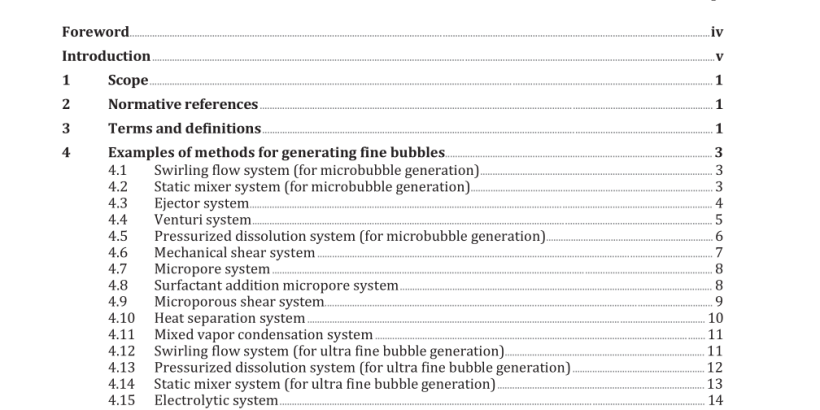ISO 20480-3:2021 pdf download – Fine bubble technology — General principles for usage and measurement of fine bubbles — Part 3: Methods for generating fine bubbles.
1 Scope This document describes methods for generating fine bubbles.
2 Normative references The following documents are referred to in the text in the sense that some or all of their content constitutes requirements of this document. For dated references, only the edition cited applies. For undated references, the latest edition of the referenced document (including any amendments) applies. ISO 20480-1, Fine bubble technology — General principles for usage and measurement of fine bubbles — Part 1: Terminology ISO 20480-2, Fine bubble technology — General principles for usage and measurement of fine bubbles — Part 2: Categorization of the attributes of fine bubbles 3 Terms and definitions For the purposes of this document, the terms and definitions given in ISO 20480-1 and ISO 20480-2, and the following apply. ISO and IEC maintain terminological databases for the use in standardization at the following addresses: — ISO Online browsing platform: available at https://www.iso .org/obp — IEC Electropedia: available at http://www.electropedia .org/ 3.1 flow path passage that conveys fluid [SOURCE: ISO 5598:2020, 3.2.302] 3.2 cavitation formation and collapse of bubbles in a liquid when the pressure falls to or below the liquid vapour pressure, the collapse releases energy, sometimes with an audible sound and vibration [SOURCE: ISO 16904:2016, 3.7]
4.13 Pressurized dissolution system (for ultra fine bubble generation) The water in the tank is pressurized using a pump and force-fed to the pipe. The inner diameter of the pipe is reduced for the liquid flow to be accelerated to reduce the static pressure below atmospheric pressure. The difference in static pressures introduces the gas from outside to the pipe. Enlarged cross section following a part of the pipe reduces the flow speed of two-phase gas-liquid to allow sufficient mixing. The flow path is restricted in the nozzle section and the pressure in the pressurized solution section is maintained at a high level of producing the maximum dissolution of the gas in the water. The water has become saturated as a result of gas dissolution under high pressure. Subsequently the pressure is reduced to atmospheric pressure at the nozzle, and the dissolved gas, whose solubility has decreased, is turned into microbubbles that are separated out from the water. The microbubbles in the water tank gradually rise on the water, leaving clear water behind. The ultrafine bubbles do not rise and are retained in the water, see Figure 13.
4.14 Static mixer system (for ultra fine bubble generation) When liquid containing large bubbles passes along a complex winding flow path, considerable shear flow is generated as the liquid passes from one mini-chamber to the next, and the large bubbles in the liquid are gradually broken up. Moreover, when the liquid passes through certain mini-chambers, the two-phase gas-liquid flow is separated into flows to multiple mini-chambers. Meanwhile in other mini- chambers the two-phase gas-liquid flows from multiple interfacing mini-chambers flow together. For this reason, the liquid is folded into itself, dramatically along with the pulverization of the bubbles while increasing the speed at which the gas is dissolved into the liquid. The consequent cloudy white water is left to stand in order to allow all of the microbubbles to float up, while separating the microbubbles from the water and retaining ultrafine bubbles, see Figure 14.
4.5 Pressurized dissolution system (for microbubble generation) The water in a container is sucked in by a pressurizing pump. When the liquid flow passes through a narrower cross section, the gas is sucked from outside into the pipe due to the negative static pressure. The introduced gas is forcefully mixed with the water. The water oversaturated with gas in a pressurized state returns to normal pressure when it passes through the nozzle. As a result, the generation of bubble nuclei is promoted. The bubble nuclei that are discharged into the liquid as the liquid flows from the nozzle grow to numerous fine bubbles through the absorption of oversaturated dissolved gas as a result of mass transfer, see Figure 5 . NOTE 1 No recirculation stream is used for the fine bubble generating system. All the volume flow is saturated with air end decompressed (full stream saturation). NOTE 2 The pressurized air is introduced to the pressure side of the pump, usually directly into the saturator (retention tank/surplus gas separation).
